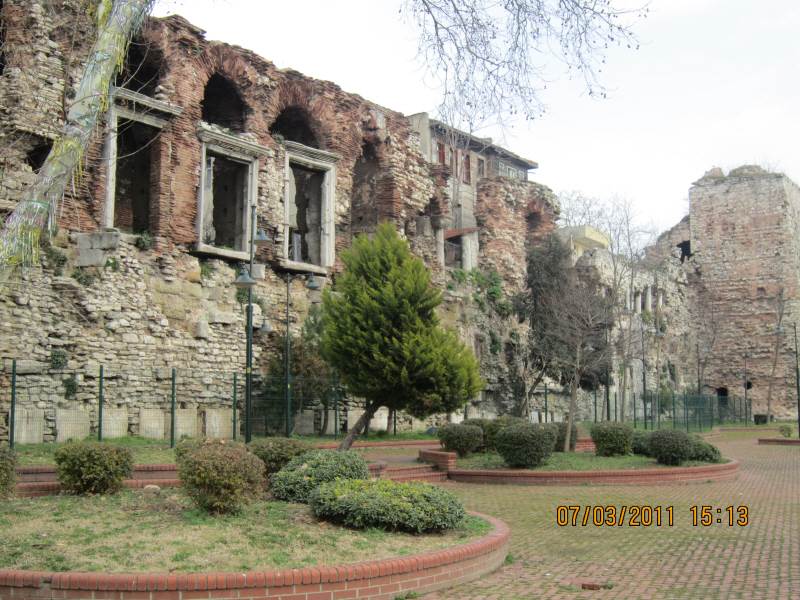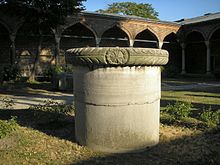 History of Istanbul
History of Istanbul
[edit] First settlements
Main article: Byzantium

Byzantine remains of a column found at Byzantium's acropolis, located today within the Topkapı Palace complex.
However, the history of Istanbul generally begins around 660 BC,[note 1] when the settlers from Megara, under the command of King Byzas, established Byzantion (Latinised as Byzantium) on the European side of the Bosphorus. By the end of the century, an acropolis was established at the former locations of Lygos and Semistra, on the Sarayburnu.[16] The city experienced a brief period of Persian rule at the turn of the 5th century BC, but the Greeks recaptured it during the Greco-Persian Wars.[25] Byzantium then continued as part of the Athenian League and its successor, the Second Athenian Empire, before ultimately gaining independence in 355 BC.[26] Long protected by the Roman Republic, Byzantium officially became a part of the Roman Empire in AD 73.
Byzantium's decision to side with the usurper Pescennius Niger against Roman Emperor Septimus Severus cost it dearly; by the time it surrendered at the end of 195, two years of siege had left the city devastated.[27] Still, five years later, Severus began to rebuild Byzantium, and the city regained—and, by some accounts, surpassed—its previous prosperity.[28]
[edit] Rise and fall of Constantinople
Main article: Constantinople
Further information: Fall of Constantinople
_by_Florentine_cartographer_Cristoforo_Buondelmonte.jpg/200px-Map_of_Constantinople_(1422)_by_Florentine_cartographer_Cristoforo_Buondelmonte.jpg)
Created in 1422 by Cristoforo Buondelmonti, this is the oldest surviving map of Constantinople and the only one that predates the Ottoman conquest.
The establishment of Constantinople served as one of Constantine's most lasting accomplishments, shifting Roman power eastward and becoming a center of Greek culture and Christianity.[31][32] Numerous churches were built across the city, including the Hagia Sofia, which remained the world's largest cathedral for a thousand years.[33] The Ecumenical Patriarchate of Constantinople developed in the city, and its leader is still one of the foremost figures in the Greek Orthodox Church. Constantinople's location also ensured its existence would stand the test of time; for many centuries, its walls and seafront protected Europe against invaders from the east as well as from the advance of Islam.[32] During most of the Middle Ages and the latter part of the Byzantine period, Constantinople was the largest and wealthiest city in the western world.[34]
Constantinople began to decline after the Fourth Crusade, during which it was sacked and pillaged.[36] The city subsequently became the center of the Latin Empire, created by Catholic crusaders to replace the Orthodox Byzantine Empire, which was divided into splinter states.[37] However, the Latin Empire was short-lived, and the Byzantine Empire was restored, weakened, in 1261.[38] Constantinople's churches, defenses, and basic services were in disrepair,[39] and its population had dwindled to forty thousand from nearly half a million during the 9th century.[40][41]
Various economic and military policies instituted by Andronikos II, such as the reduction of forces, weakened the empire and left it more vulnerable to attack.[42] In the mid-14th century, the Ottoman Turks began a strategy by which they took smaller towns and cities over time, cutting off Constantinople's supply routes and strangling it slowly.[43] Finally, on 29 May 1453, after an eight-week siege (during which the last Roman Emperor, Constantine XI, was killed), Sultan Mehmed II "the Conqueror" captured Constantinople and declared it the new capital of the Ottoman Empire.[44][45] Hours later, the sultan rode to the Hagia Sofia and summoned an imam to proclaim the Islamic creed, converting the grand cathedral into an imperial mosque.[46]
[edit] Turkish rule
Main article: History of Istanbul
Following the fall of Constantinople, Mehmed II immediately set out to revitalize the city, now also known as Istanbul. He invited and forcibly resettled many Muslims, Jews, and Christians from other parts of Anatolia into the city, creating a cosmopolitan society that persisted through much of the Ottoman period.[47] By the end of the century, Istanbul had returned to a population of two hundred thousand, making it the second-largest city in Europe.[48] Meanwhile, Mehmed II repaired the city's damaged infrastructure and began to build the Grand Bazaar. Also constructed during this period was Topkapı Palace, which served as the official residence of the sultan for four hundred years.[49]The Ottomans quickly transformed Istanbul from a bastion of Christianity to a symbol of Islamic culture. Religious foundations were established to fund the construction of grand imperial mosques, often adjoined by schools, hospitals, and public baths.[49] Suleiman the Magnificent's reign from 1520 to 1566 was a period of especially great artistic and architectural achievements; chief architect Mimar Sinan designed the Süleymaniye Mosque and other grand buildings in the city, while Ottoman arts of ceramics, calligraphy and miniature flourished.[50] The total population of Istanbul amounted to 570,000 by the end of the 18th century.[51]
.jpg/220px-Bridge_and_Galata_Area,_Istanbul,_Turkey_by_Abdullah_Fr%C3%A8res,_ca._1880-1893_(LOC).jpg)
View of the Galata Bridgespanning the Golden Horn, with the Galata Tower in the background, ca. 1892-1893

The last Ottoman sultan, Mehmed VI, departing from the backdoor of the Dolmabahçe Palace a year before the declaration of the Republic of Turkey.
In the early years of the republic, Istanbul was overlooked in favor of the country's new capital, Ankara. However, starting from the late 1940s and early 1950s, Istanbul underwent great structural change, as new public squares (such as Taksim Square), boulevards, and avenues were constructed throughout the city, sometimes at the expense of historical buildings.[60] The population of Istanbul began to rapidly increase in the 1970s, as people from Anatolia migrated to the city to find employment in the many new factories that were built on the outskirts of the sprawling metropolis. This sudden, sharp rise in the city's population caused a large demand for housing development, and many previously outlying villages and forests became engulfed into the greater metropolitan area of Istanbul.[61]
Architecture
Main article: Architecture of Istanbul
Istanbul is primarily known for its Byzantine and Ottoman architecture, but its buildings reflect the various peoples and empires that have ruled its predecessors. Genoese, Roman, and even Greek forms of architecture remain visible in Istanbul alongside their Ottoman counterparts. Similarly, while the Hagia Sophia and imperial mosques dominate much of the city's skyline, the city is also home to a number of historic churches and synagogues.
Panoramic view of the Golden Horn in Istanbul, as seen from the Galata Tower. The Galata Bridge can be seen in the centre of the picture. The Seraglio Point where the Topkapı Palace is located is seen at the left tip of the historic peninsula; followed by (left to right) the Hagia Sophia, theSultan Ahmed Mosque, the Yeni Mosque near the Galata Bridge, the Beyazıt Tower rising high in the background, and the Süleymaniye Mosque at far right, among others. The Sea of Marmara and the Princes' Islands are seen in the background, on the horizon. At the extreme left of the picture, the district of Kadıköy (ancient Chalcedon) on the Asian side of the city can be seen. Behind the Galata Bridge, towards the horizon, the Column of Constantine (which was surrounded by iron bars for restoration) rises.
Historic Areas of Istanbul*
UNESCO World Heritage Site
State Party
 Turkey
Turkey
Type
Cultural
Criteria
I, II, III, IV
Reference
356
Region**
Europe and North America
Inscription history
Inscription
1985 (9th Session)
* Name as inscribed on World Heritage List.
** Region as classified by UNESCO.
More than two thousand years following the departure of the Greeks, few examples of Istanbul's Greek architecture have survived. Perhaps the most prominent relic of the Greek era is Maiden's (Leander's) Tower. Residing on an islet in the Bosphorus just off the coast of Üsküdar, Maiden's Tower was first built by the Greeks in 411 BC to guide ships within the strait. Since then, however, the tower has undergone a number of enlargements and restorations, rendering its connection to the Greeks tenuous, and today merely serves as an observation point.[83]
 A mix of old and new, as roads now travel through the arches of the 4th-century Valens Aqueduct.Examples of Roman architecture have proved themselves to be more durable. Obelisks from the Hippodrome of Constantinople, modeled after the Circus Maximus in Rome, are still visible in Sultanahmet Square.[84] A section of the Valens Aqueduct, constructed in the late 4th century to carry water to the city, stands relatively intact over 970 meters (3,200 ft) in the west of the Fatih district.[85] Similarly, the Walls of Constantinople, which were erected in stages well into the Byzantine period, are still visible along much of their original 4-mile (6.4 km) course from the Sea of Marmara to the Golden Horn.[86] Finally, the Column of Constantine, erected in 330 AD to mark the new Roman capital, still stands not far from the Hippodrome.[85]
A mix of old and new, as roads now travel through the arches of the 4th-century Valens Aqueduct.Examples of Roman architecture have proved themselves to be more durable. Obelisks from the Hippodrome of Constantinople, modeled after the Circus Maximus in Rome, are still visible in Sultanahmet Square.[84] A section of the Valens Aqueduct, constructed in the late 4th century to carry water to the city, stands relatively intact over 970 meters (3,200 ft) in the west of the Fatih district.[85] Similarly, the Walls of Constantinople, which were erected in stages well into the Byzantine period, are still visible along much of their original 4-mile (6.4 km) course from the Sea of Marmara to the Golden Horn.[86] Finally, the Column of Constantine, erected in 330 AD to mark the new Roman capital, still stands not far from the Hippodrome.[85]
 The Hagia Sophia as it stands today, with the minarets added by the OttomansEarly Byzantine architecture followed the classical Roman model of domes and arches, but further improved these architectural concepts, as in the Church of the Saints Sergius and Bacchus. The oldest surviving Byzantine church in Istanbul (albeit partially in ruins) is the Stoudios (İmrahor) Monastery, which was built in 454.[87] Other extant structures from the early Byzantine period include the Hagia Irene, initially the first church in the new capital, and the Prison of Anemas, which was incorporated into the city walls. After the recapture of Constantinople in 1261, the Byzantines constructed two of their most important churches, Chora Church and Pammakaristos Church. Across the Golden Horn, the Genoese contributed Galata Tower, then the highest point in the citadel of Galata. Still, the pinnacle of Byzantine architecture, and one of Istanbul's most iconic structures, is the Hagia Sophia. Topped by a dome 31 meters (102 ft) in diameter,[88] the Hagia Sofia stood as the largest cathedral for more than a thousand years, before being converted into a mosque and, now, a museum.[33][46]
The Hagia Sophia as it stands today, with the minarets added by the OttomansEarly Byzantine architecture followed the classical Roman model of domes and arches, but further improved these architectural concepts, as in the Church of the Saints Sergius and Bacchus. The oldest surviving Byzantine church in Istanbul (albeit partially in ruins) is the Stoudios (İmrahor) Monastery, which was built in 454.[87] Other extant structures from the early Byzantine period include the Hagia Irene, initially the first church in the new capital, and the Prison of Anemas, which was incorporated into the city walls. After the recapture of Constantinople in 1261, the Byzantines constructed two of their most important churches, Chora Church and Pammakaristos Church. Across the Golden Horn, the Genoese contributed Galata Tower, then the highest point in the citadel of Galata. Still, the pinnacle of Byzantine architecture, and one of Istanbul's most iconic structures, is the Hagia Sophia. Topped by a dome 31 meters (102 ft) in diameter,[88] the Hagia Sofia stood as the largest cathedral for more than a thousand years, before being converted into a mosque and, now, a museum.[33][46]
 Dolmabahçe Palace, an example of the Ottoman Baroque architecture.Among the oldest extant examples of Ottoman architecture in Istanbul are the Anadoluhisarı and Rumelihisarı fortresses, which helped block sea traffic aimed at assisting the Byzantines during the Turkish siege of the city.[89] Over the next four centuries, the Ottomans continued to make an indelible impression on the skyline of Istanbul, building towering mosques and ornate palaces. These grand imperial mosques include Sultan Ahmed Mosque (the Blue Mosque), Süleymaniye Mosque, and Yeni Mosque, all of which were built at the peak of the Ottoman Empire, in the 16th and 17th centuries.
Dolmabahçe Palace, an example of the Ottoman Baroque architecture.Among the oldest extant examples of Ottoman architecture in Istanbul are the Anadoluhisarı and Rumelihisarı fortresses, which helped block sea traffic aimed at assisting the Byzantines during the Turkish siege of the city.[89] Over the next four centuries, the Ottomans continued to make an indelible impression on the skyline of Istanbul, building towering mosques and ornate palaces. These grand imperial mosques include Sultan Ahmed Mosque (the Blue Mosque), Süleymaniye Mosque, and Yeni Mosque, all of which were built at the peak of the Ottoman Empire, in the 16th and 17th centuries.
In the following centuries, and especially after the Tanzimat reforms, Ottoman architecture was supplanted by European styles. In contrast to the traditional elements of Topkapı Palace and the mosques on the historic peninsula, Dolmabahçe Palace, Yıldız Palace, and Ortaköy Mosque in Beşiktaş, and Beylerbeyi Palace across the Bosphorus in Üsküdar are clearly of Neo-Baroque style. At the same time, the areas around İstiklal Avenue were filled with grandiose European embassies and rows of buildings in European (mostly Neoclassical and, later, Art Nouveau) style started to appear along the avenue. Istanbul was one of the major centers of the Art Nouveau movement in the late-19th and early-20th centuries, with famous architects of this style building palaces and mansions in the city.
Panoramic view of the Golden Horn in Istanbul, as seen from the Galata Tower. The Galata Bridge can be seen in the centre of the picture. The Seraglio Point where the Topkapı Palace is located is seen at the left tip of the historic peninsula; followed by (left to right) the Hagia Sophia, theSultan Ahmed Mosque, the Yeni Mosque near the Galata Bridge, the Beyazıt Tower rising high in the background, and the Süleymaniye Mosque at far right, among others. The Sea of Marmara and the Princes' Islands are seen in the background, on the horizon. At the extreme left of the picture, the district of Kadıköy (ancient Chalcedon) on the Asian side of the city can be seen. Behind the Galata Bridge, towards the horizon, the Column of Constantine (which was surrounded by iron bars for restoration) rises.
** Region as classified by UNESCO.

A mix of old and new, as roads now travel through the arches of the 4th-century Valens Aqueduct.

The Hagia Sophia as it stands today, with the minarets added by the Ottomans

Dolmabahçe Palace, an example of the Ottoman Baroque architecture.





